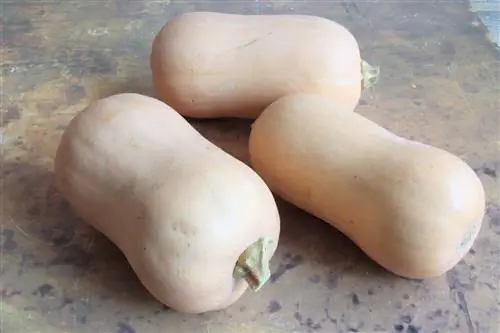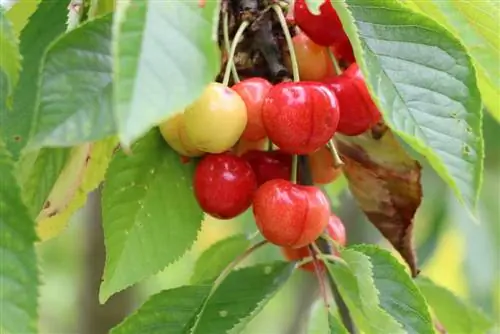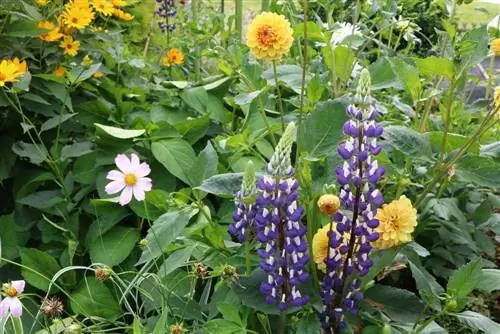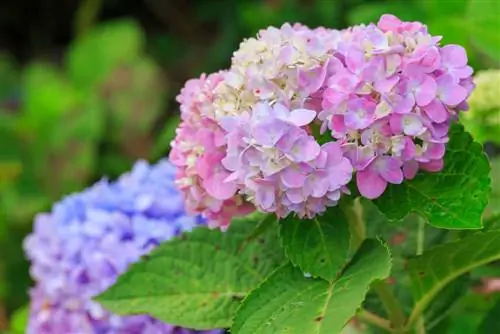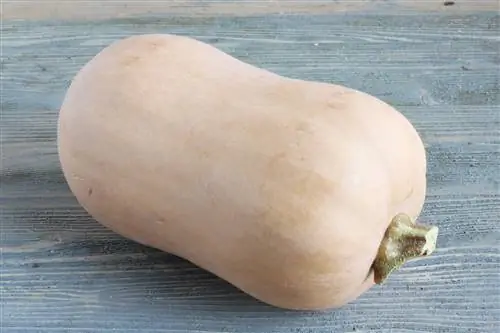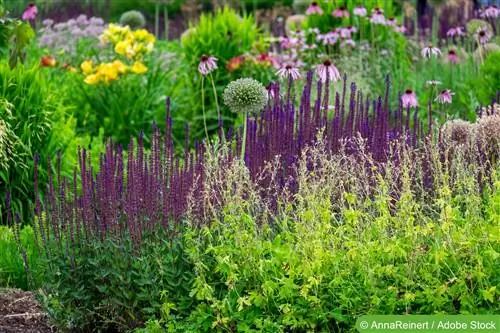- Author admin [email protected].
- Public 2023-12-17 03:39.
- Last modified 2025-01-24 12:45.
The butternut squash is a musk squash and is becoming increasingly popular outside of its American homeland thanks to its flavor and soft, non-fibrous flesh. No wonder it is found more and more often in the vegetable patch. However, the conditions for cultivation must be right here and there are also some important points to follow in cultivation so that numerous, he althy fruits can appear. Interested hobby gardeners will find out below what needs to be taken into account when caring for the harvest.
Location
The butternut squash wants to be pampered by the sun, so the location should be bright and warm. A sheltered, very sunny location, for example towards the south, is favourable. The plant is not particularly sensitive to wind, but it does not suffer from cold or shade. A slightly elevated location or a bucket that is insulated against the cold of the ground and can be moved if necessary can therefore prove to be beneficial.
Tip:
Do not grow in areas with high groundwater or in those where rainwater accumulates for a long time.
Substrate
If you want to do something particularly good for the butternut squash, put it directly on the compost. The high nutrient content allows the plant to sprout vigorously and usually with high yields. Alternatively, the butternut squash can also be placed in nutrient-rich plant or vegetable soil and also added compost. Since the pumpkin does not tolerate waterlogging, drainage in soil that tends to compact can be improved by mixing in sand. In addition to spreading or mixing the right substrate, the future bed should be slightly loosened and freed from weeds.
Pre-breeding and sowing
As a heat-loving plant, butternut squash requires higher temperatures right from the start, so it is recommended to pre-germinate the seeds in the greenhouse or on the windowsill. The seeds are placed individually in potting soil between March and May and placed in a warm, sunny location. The substrate is kept slightly moist throughout. The young plants can be placed in the bed in May or after the last ground frost. At this time, sowing directly outdoors is also possible. Special potting soil can then be dispensed with, but measured and regular watering is also necessary here.
Plants and cultivation
If you don't want to prefer early cultivation or are a little too late to sow, you can also purchase early butternut squash plants in stores. These are placed directly in the bed, which is also possible in June or July. Just like when sowing, pay attention to a distance of one meter in and between the rows, because the butternut squash forms long tendrils.
To make growing butternut squash easier to care for, it is recommended to apply a layer of mulch immediately after planting. This reduces evaporation and thus reduces the amount of watering required. In addition, checks for snails should be carried out daily if possible in the first few weeks. These often feast on young butternut squash plants and can cause considerable damage. Here again, culture in the bucket proves to be beneficial. Otherwise, the snails should be harvested or, alternatively, the plants should be covered. Transparent plastic covers that are placed over the young plants are useful for this purpose.
Irrigation
In order for the plants to thrive and the cultivation to be successful, the butternut squash needs plenty of water. The soil should always be kept slightly moist, but it is important to avoid waterlogging. Ideally, watering is done with rainwater or stale tap water; untreated pond water can also be used. In regions with soft water, the hose can of course be used. In dry phases and during the initial strong growth, watering is usually necessary daily. If possible, water so that the soil gets wet, but not the leaves.
Fertilize
If the first flowers appear on the butternut squash, additional nutrients may be added. Horn shavings, special vegetable fertilizer or compost are well suited. Whatever you choose, the product is applied around the plants and only hooked in very lightly. Since the roots run shallowly beneath the surface, the risk of injuring them is high. So caution is required here. The butternut squash is fertilized in dry weather so that it can be watered abundantly after the product has been applied. This measure means that the nutrients are distributed better and there is no risk of chemical burns on the roots. If the substrate proves to be nutrient-poor in soil tests, another fertilizer application can be made about a month after the first.
Tip:
If you enrich the soil with compost, water it with pond water or occasionally add plant manure and spread mulch, you can usually do without additional fertilizing.
Simply
If you want to harvest a few, but particularly large, butternut squash, you should plant the plants early. The right time for this measure has come when the fruits are clearly visible behind the flowers. In order to specifically direct growth, the five strongest fruits are selected and only these are left standing. All others are pinched off or cut off along with unnecessary side shoots. In this way, the butternut squash plant concentrates its strength solely on the remaining fruits. If you prefer to have several smaller fruits, you can avoid pinching out the flowers. However, it still makes sense to remove side shoots that do not have buds.
Harvesting and storage
In order to harvest intact butternut squash, the fruits should not lie directly on the ground. Instead, it is better to place wooden boards or foil underneath, for example. The harvest time can vary significantly depending on the variety you choose. In any case, maturity is shown in two ways. On the one hand, the handle visibly becomes woody, becomes dry and can hardly be cut with a normal kitchen knife. On the other hand, the fruits sound hollow when tapped. Since the butternut pumpkins themselves cannot tolerate frost, they must be harvested before the first freezing temperatures.
The butternut squash is quite easy to store if it is stored at a maximum temperature of 12 °C, frost-free and in a dark place.
Different types of pumpkin
The particularly popular and tasty pumpkins include Hokkaido, butternut and nutmeg pumpkin. The Hokkaido pumpkin is a medium-sized Japanese variety. It is bright orange both inside and out and its flesh is very aromatic. The butternut squash is characterized by its light yellow color and pear shape. The flesh of the Early Butternut is deep orange and its taste is intense and spicy. The butternut is a musk squash that is small and manageable in size. A fully grown pumpkin of this type weighs around one kilo. The medium-sized nutmeg pumpkin has a brownish-green-orange skin color. The flesh is strong and, like Hokkaido and butternut, can be eaten raw or cooked. A mature nutmeg pumpkin weighs up to five kilos.
What you need to know about pumpkin plants in brief
Care measures
- Loosing and hoeing the soil must be done with great care as the pumpkin roots run close to the surface.
- If the fruits can be seen behind the pumpkin blossoms, the plants are being harvested. You clip off excess flowers.
- If only two to three flowers remain on each tendril, you will get larger and stronger fruits.
- During the growth phase, the pumpkin needs special nutrients, sun and water.
- The plant soil must be kept evenly moist. However, the pumpkin is not watered from above so that the leaves remain dry.
- From July to August the plants grow daily, so they need support to prevent them from falling off the vine.
- To protect against rot, place a wooden or Styrofoam board under the fruit.
- If pumpkin leaves turn white or brownish, this can be a sign of powdery mildew. In this case, the affected leaves are simply removed.
Species diversity
- Basically, pumpkins are divided into three different groups of varieties: garden pumpkins, ornamental pumpkins and edible pumpkins.
- Wild pumpkin species often contain bitter substances. These can cause diarrhea, vomiting, headaches and circulatory problems.
- Decorative pumpkins are not edible for this reason and are used exclusively for decorative purposes.
- Garden pumpkins and pumpkins, on the other hand, are very he althy and tasty.
Usage
- The pulp of pumpkins is rich in water and fiber, which has a positive effect on intestinal activity and digestion.
- Pumpkin juice is a nutritious vegetable drink that contains all vitamins and minerals such as magnesium, iron, copper and potassium.
- Pumpkins have a flushing effect and thus support the breakdown of fat deposits.
- In addition, products containing pumpkin strengthen the immune system and the protective layer of the nerves.
Conclusion
If the butternut squash is provided with a sunny and warm location, sufficient nutrients and water, cultivation is quite simple and is therefore possible without any problems, even without a green thumb. If you also follow the tips mentioned, you can look forward to a surprisingly large yield and numerous dishes. Pumpkin plants are easy to cultivate garden plants that can be sown directly into the outdoor bed from mid-May. When pre-growing in pots, the pumpkin seeds are sown from April 20th. As soon as the cotyledons are fully formed, the young pumpkin plants are transplanted into larger pots with propagation soil. For planting in the outdoor bed, soil low in humus and enriched with compost is recommended. Horn semolina and mineral nitrogen fertilizers are suitable as fertilizers.

